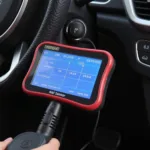Imagine this: you hop into your luxurious 2008 Range Rover, eager to take it for a spin. But then, disaster strikes! Your trusty OBD2 scanner, usually a beacon of diagnostic clarity, remains stubbornly dark. No power to the OBD2 port. What could be causing this frustrating issue, and how can you get your scanner back online? This article dives deep into the common culprits behind a powerless OBD2 port in a 2008 Range Rover, providing you with the knowledge to troubleshoot and conquer this automotive hiccup.
Unraveling the Mystery: Why No Power to the OBD2 Port?
The OBD2 port in your 2008 Range Rover is the gateway to understanding your vehicle’s inner workings. When it lacks power, the flow of diagnostic information grinds to a halt. Let’s explore the usual suspects:
1. Blown Fuses: The First Line of Defense
Fuses act as safety guards, protecting your vehicle’s electrical system from overloads. A blown fuse is often the culprit behind a powerless OBD2 port. Check your Range Rover’s fuse box, usually located under the dashboard or hood, and inspect the fuse associated with the OBD2 port. A blown fuse will have a broken wire or a darkened glass tube.
2. Loose or Damaged Wiring: Tracing the Electrical Pathway
Over time, the wiring connected to your OBD2 port can become loose, corroded, or damaged. Examine the wiring harness leading to the port for any visible signs of wear and tear, such as fraying, cuts, or loose connections. A compromised wire can disrupt the flow of power.
3. Faulty OBD2 Port: A Closer Look
While less common, a malfunctioning OBD2 port itself can lead to power issues. Inspect the port for any bent or damaged pins, debris, or corrosion. These issues can prevent your scanner from making a proper connection and receiving power.
4. Problematic Cigarette Lighter Fuse: An Unexpected Connection
In some cases, the OBD2 port shares a fuse with the cigarette lighter. If you’re experiencing issues with both, a blown cigarette lighter fuse could be the culprit.
5. Underlying Electrical Gremlins: Delving Deeper
If a visual inspection of fuses, wiring, and the port doesn’t reveal the source of the problem, a deeper electrical issue might be at play. This could involve a faulty relay, a problematic ground connection, or even issues with the vehicle’s electronic control unit (ECU).
Troubleshooting Tips: Getting Your OBD2 Port Powered Up
Now that you have a better understanding of the potential causes, let’s explore some troubleshooting steps:
-
Check the Obvious: Begin by ensuring your OBD2 scanner is functioning correctly and that the connection to the port is secure. Sometimes, the simplest solution is the right one.
-
Consult Your Owner’s Manual: Your Range Rover’s owner’s manual is a treasure trove of information. It will pinpoint the exact location of the fuse box and identify the specific fuse related to the OBD2 port.
-
Test for Power: Use a multimeter or a test light to check for power at the OBD2 port. This will help determine if the issue lies with the port itself or the wiring leading to it.
-
Inspect and Clean: Carefully examine the OBD2 port for any debris or corrosion. Use a can of compressed air to remove dust and dirt. If corrosion is present, gently clean the pins with electrical contact cleaner.
Seeking Professional Help: When in Doubt, Consult an Expert
If your troubleshooting efforts don’t resolve the power issue or you’re uncomfortable working with electrical components, it’s always best to seek assistance from a qualified mechanic or an auto electrician. They have the expertise and tools to diagnose and repair complex electrical problems effectively.
Conclusion: Powering Up Your Diagnostic Journey
A powerless OBD2 port can be frustrating, but understanding the common causes and employing basic troubleshooting techniques can get you back on track. Remember, a properly functioning OBD2 port is crucial for diagnosing and resolving issues in your 2008 Range Rover.
If you encounter persistent problems, don’t hesitate to consult with a professional. They can provide the expert assistance needed to restore power to your diagnostic port and keep your Range Rover running smoothly.
FAQs: Addressing Common Concerns
Q: Can a dead car battery cause a powerless OBD2 port?
A: Yes, a completely dead battery won’t provide power to the OBD2 port.
Q: Is it safe to drive with a powerless OBD2 port?
A: While the OBD2 port itself doesn’t directly affect your vehicle’s drivability, it’s crucial to address the underlying electrical issue that’s causing the power loss.
Q: How often should I check my OBD2 port for issues?
A: It’s a good practice to visually inspect your OBD2 port for any signs of damage or corrosion during routine maintenance checks.
Need further assistance with your OBD2 scanner or automotive diagnostics? Reach out to our dedicated support team via WhatsApp: +1(641)206-8880 or Email: [email protected]. We’re here to help 24/7.


